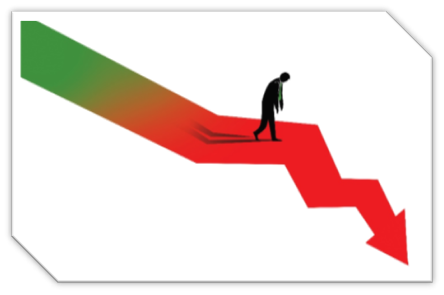Source:Phongphan, Shutterstock
Summary
- The last one year has been challenging for most of the businesses across the globe
- Stock markets have been on a wild ride since the Covid-19 vaccine shot co-developed by Pfizer and BioNTech got promising results
Stocks, currencies, commodities, derivatives, fixed-income securities, and other market-tradable assets have witnessed a never-seen-before volatility in the recent past. We have now completed a year when the nations around the world started to freeze their respective travel arrangements by imposing restrictions in the name of country-wide lockdowns.
A year of the first lockdown
The last one year has been challenging for most of the businesses of any size or scale, some have exceptionally flourished in the meantime but a majority of them have faced the heat from all sides.
Markets have reflected the dejection very clearly right after the World Health Organization (WHO) declared the Covid-19 (CoV-2 SARS) as a global pandemic. Led by a series of mini corrections, the global stocks indices retreated sharply from their respective multi-year highs and all-time peaks.
Investors’ optimism can be now felt with most of the benchmark indices hovering at their 52-week highs alongside the steep bounce back in the crude oil prices and apparently diminishing demand for safe-haven assets. Markets have been on a wild ride since the Covid-19 vaccine shot co-developed by Pfizer and BioNTech got promising results in Phase 3 clinical trials. Especially in the last four months, market participants across the globe are gushed with vaccine optimism and hopes of moderations in the restrictions that will eventually allow the deprived businesses to restart their commercial set-ups.

Copyright © 2021 Kalkine Media Pty Ltd.
Enterprises restarting with limited operations at the beginning as the relaxations from the pandemic-induced curbs have seemingly instituted a definitive path of recovery with nations talking about building back stronger from the bottoms realised during the peak of the coronavirus crisis.
The industries that were mainly affected due to the travel curbs, cross-border restrictions, and limitations in the local jurisdictions are hoping for an immediate silver lining. A large section of businesses involved in tourism, travel, aviation, leisure, expensive consumer products, services industry, oil marketing companies, and several other severely influenced entities due to the coronavirus pandemic and its life-threatening aftermath have encountered several unforeseen challenges in keeping up the ‘going concern’ principle intact.
Massive cost-reduction measures, big-ticket layoffs, organisation restructuring, streamlining overheads and fixed costs and limiting the number of operations were some of the major steps that were undertaken by most of the corporations. These measures came into light at a time when healthcare administrations were handling the pressure of extensively high hospital admissions, critically soaring rate of infections and the subsequent fatal cases.
Blurry optimism?
Now with the advent of multiple vaccine candidates, an obvious calmness has developed amidst the investors as most of the fund houses, portfolio managers and research firms are anticipating a faster-than-expected recovery. But the challenges are not over.
With the multiple resurgences of Covid-19 cases across the world, the pandemic worries and the related uncertainty has renewed. It would be outrightly incorrect to say that the hardships have been alleviated completely, given the sharp gains in the stock indices from New York to London to Tokyo.
Of late, the apparent case of flawed vaccine roll-out and reports of adverse effects of the Covid-19 jab in many nations, including European, Asian, African and South American countries, has once again renewed the hysteria around the pandemic, bringing the attention of the drug regulators of respective geographies.
Markets have reacted extensively to these developments. However, the fears were short-lived after the UK drug regulator Medicines and Healthcare products Regulatory Agency (MHRA) and European Union’s medicines regulator EMA’s safety committee (PRAC) restated that the potential benefits of the Oxford-AstraZeneca Covid-19 vaccine outweigh the adverse effects. The low proportion of noticeable effects in the humans who received the Oxford jab has defied the waves of uncertainty.
Revival at stake
As far as the monetary and fiscal responsiveness of nations is concerned, the respective central banks are still finding it difficult to achieve the predefined target for inflation. The Bank of England, in its latest Monetary Policy Committee (MPC) meeting held in the third week of March, has reiterated the potential advantages of extension of relief measures by the government of the United Kingdom.
But the central bank also highlighted the grave concerns around the snowballing unemployment rate and the upcoming challenges with regard to the pandemic as the virus is still evolving.
Riding high on the back of a humongous Covid relief bill of $1.9 trillion, the market participants are unfazed by the apprehensiveness while dealing with various assets, including equities, currencies, and commodities. The meaningful revision in the global, as well as country-wise GDP growth forecast by the Organisation of Economic Co-operation and Development (OECD), has furthered the hopes of a quicker recovery.
Nonetheless, the markets remain in awe to gauge the prospective consequences of macro indicators on the markets. According to the Office for National Statistics (ONS), the unemployment rate in January 2021 decreased marginally to 5 per cent from 5.1 per cent in December 2020. It is still 1.1 per cent higher than the unemployment rate in the same period a year earlier.
Notably, the ONS estimates for the economic inactivity suggests that 21 per cent of people were out of work but seeking jobs during the three-month period between November 2020 and January 2021. This is the highest rate since June-August 2019.
The rate of economic inactivity increased by 0.6 per cent over the year, the largest annual increase since February to April 2010, ONS said. While, on the other hand, employment in the United Kingdom decreased by a little more than 147,000 in December 2020.
To conclude, the market-wide challenges and macroeconomic shortcomings still have the potential to tremble the investors’ optimism as the coronavirus-like grey swan event has not been witnessed in modern history before 2020. However, the markets progress ahead by factoring in a lot of uncertainties alongside the long range of benefits in the upcoming 5 to 10 years.
It would be eventful to watch how effective is the vaccination programme as many countries began to finish the inoculation cycle of two doses.




